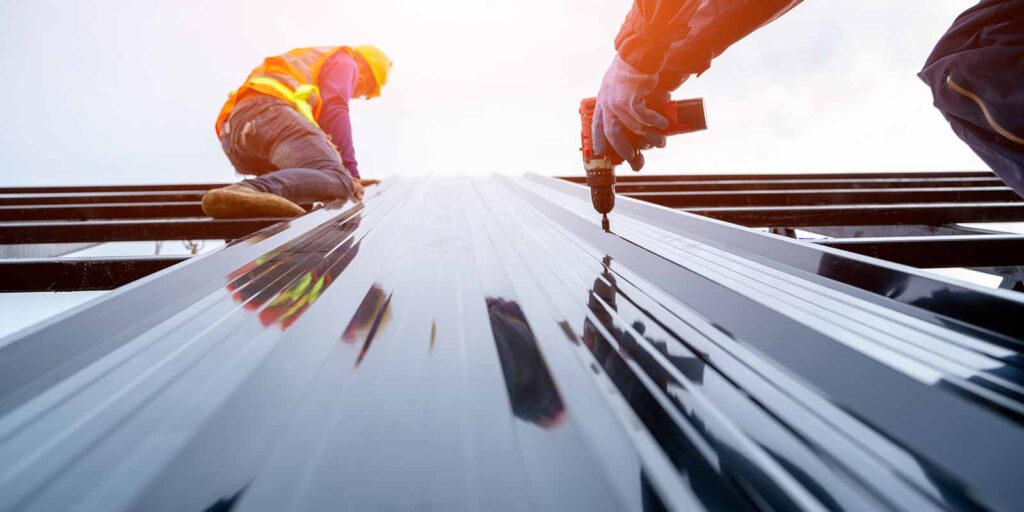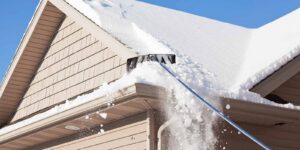As roofing experts, we aren’t surprised to see that metal roofs are becoming more popular with both homeowners and builders in the United States. While asphalt shingles remain the most popular roofing material, metal is in second place, and for many good reasons!
Metal roofing panels have excellent longevity, and homeowners can choose from traditional coppers and tins to sleek black or a pop of red and everything in between. But, as with any building material, there are some cons. Before investing in a metal roof, homeowners should understand the positive and negative aspects below.
Metal Roof Pros
Longevity: Metal roofs can last over 50 years with proper installation and maintenance, making them one of the longest-lasting roofing options. In the past, homeowners had concerns about rusting, but modern metal roofing panels have a protective coating that inhibits rust formation.
Heat Reflection: Metal is usually thought of as a conductive material, but metal roofs actually reflect sunlight rather than absorbing it. When this material works as a system with a correctly ventilated attic, the heat reflection can reduce your temperature regulation costs.
Environmentally Friendly: you will find that many metal roofing materials are comprised of 25-95% recycled content. Plus, they are 100% recyclable, meaning that they can be recycled at the end of the roof’s life rather than contributing to landfill waste as other roofing materials do.
Customizable: There are so many colors to choose from with modern metal roofing materials! Metal roofing can be a unique piece, like a copper accent over a bay window, or can enhance a home’s aesthetic such as in modern farmhouse designs. With both bright colors and traditional metallics, you can find a metal roof that will fit just about any type of home.
Fire Resistant: Metal roofing will not catch fire from the elements like a wildfire or lightning strike. Most other roofing materials do not provide as much protection.
Rain and Snow Resistance: In a metal roofing system, the panels interlock so that the roof’s surface is hard and slippery. That means rain and snow can run down the roof more easily than with other materials, as long as the roof is installed correctly.
Metal Roof Cons
Cost: You have probably heard that metal roofing is expensive, and it’s true that it does cost on average 2 to 3 times more than popular asphalt shingles. Unfortunately, this price can be prohibitive. However, if a metal roof isn’t in your budget right now but you would like to get the look, consider replacing accent areas, like over a porch or window awning, with metal roofing materials.
Noise Level: A traditional asphalt roof is made of different layers that buffer sound throughout your home. Metal roofs do not have the same layer system. Some homeowners report that the noise from heavy rain or a hailstorm can be particularly loud on a metal roof. However, this noise can be reduced significantly when your attic is correctly insulated.
Incorrect Installation: Metal roofing is actually quite simple to install IF the contractor is experienced. As with any roof replacement, if the materials are not installed correctly, the roof will leak. Make sure you research your roofing company and ask for examples of metal roofs they have installed in the past.
Storm Damage: As mentioned above, metal roofs are very durable. However, they are prone to dents if there is a very heavy hailstorm or branches fall on the house. But, in reality, if the storm is rough enough to damage a metal roof, it would have damaged most any roofing material. The difference is that single shingles can be replaced, whereas roofing panels are harder to repair.
Repair Options: Metal roofing is installed in panels, and those panels are much more challenging to replace than a single asphalt shingle. Additionally, if you choose a unique color option, it can be tough to find matching patches to make a repair.
Leaks: There are two main types of metal roofing systems, standing seam, and exposed fasteners. Most exposed fastener systems are not engineered to the same standard as a standing seam. Many experienced roofers do not recommend or even install exposed fastener metal roofing due to the tendency of rainwater to seep through the exposed screw holes.
Now that you’ve read the pros and cons of metal roofs, would you install one on your home? If you’re considering a metal roof or need to replace an existing one, get matched with a trusted local roofer that has experience in metal roofing. They can help you find the best solution for your home, whichever roofing material you choose.




